#protogynous hermaphrodite
Explore tagged Tumblr posts
Text

Slippery Dick (Halichoeres bivittatus), family Labridae, order Labriformes, found in the tropical western Atlantic
Like many wrasses, this fish is a protogynous hermaphrodite, starting life as a female, and becoming male later in life.
photograph by Florent Charpin
772 notes
·
View notes
Text
Daily fish fact #813
Peppermint angelfish!

It lives 53 to 120 meters (174 to 394 feet) deep which makes it a rare sight — and very expensive in the aquarium trade. Like other marine angelfish, it is a protogynous hermaphrodite, which means that the females can change their sex to become male.
#fish#fish facts#fishfact#biology#zoology#fishblr#marine biology#marine animals#marine life#sea animals#sea creatures#sea life#angelfish#marine angelfish#peppermint angelfish
165 notes
·
View notes
Text
Wet Beast Wednesday: California Sheephead Wrasse
A lot of people through history and the modern day have an overly simplistic view about sex, both in the sense of biological sex (that is, what gametes something produces) and sex as in the act of mating. A lot of people think that sex is just a strict binary between males and females, but nature is far more diverse and varied than that (even in humans. Intersex people do exist after all). Today I'm showcasing one of the animals that completely goes against the alleged sex binary: the California Sheephead Wrasse. And yes, this is a pride post.
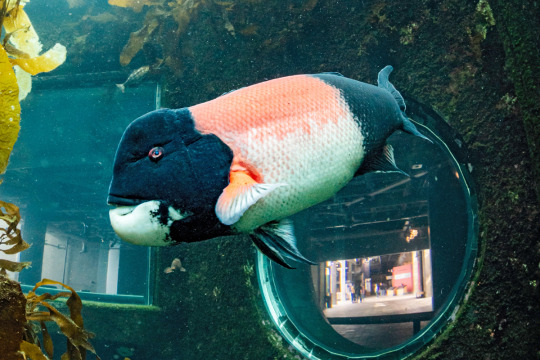
(Image: a male California Sheephead Wrasse in a tank in the Monterey Bay Aquarium. It is a large fish with a bulbous head. The head and tail are black, midsection is pink, and the belly and chin are white. End ID)
The California Sheephead (Semicossyphus pulcher) is a large fish in the Wrasse family of Labridae. They are sexually dimorphic, with the males and females appearing distinct from each other in size, shape, and color. Males are larger than females, reaching up to 91 cm (3 ft) and 16 kg (35 lbs), though there is quite a bit of size variation based on food availability. They have flatter faces than females thanks to a bulbous bump on the forehead. This lump is the namesake of the fish, since it allegedly make it look like it has a sheep's head. I personally don't see it at all. Males have black heads and tails with a white chin and underbelly and pink midsection Females are smaller and colored silvery to a dull pink all over except for their white chins and underbellies. There isn't really a maximum size or weight for females for reasons I'll get into later. The fish have large canine teeth that protrude from the mouth and modified throat bones that form a grinding apparatus called the throat plate.
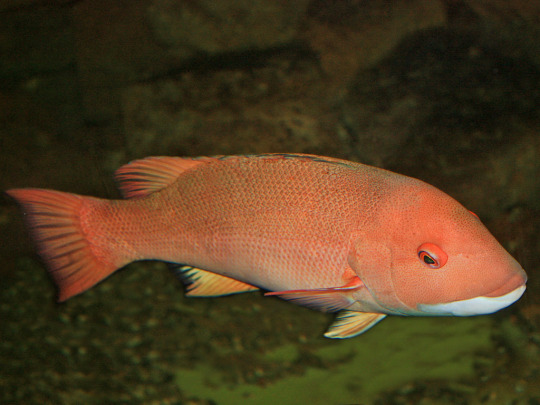
(Image: a female California Sheephead. It has a less bulbous head than the male and is a pale pink all over, except for the white belly and chin. End ID)
Sheepheads, like many wrasses, are sequential hermaphrodites. A sequential hermaphrodite can transition between sexes during its life (as opposed to a simultaneous hermaphrodite, who can produce both sperm and eggs at the same time). Every California Sheephead is born female and some will become male later in life, making them protogynous. Protogyny is the most common form of hermaphroditism in fish, with over 75% of known sequentially hermaphroditic fish species being protogynous. This transition is a one-way process, males will not turn back into females. The transition is triggered by a number of factors, primarily size and the local availability of males. If there are not enough males in the area, the largest female will transition to male to fill the role. This transition takes between 2 weeks and a few months depending on availability of food and other conditions (temperature seems to play a role) and the fish will be capable of producing sperm before fully assuming the male morphology.
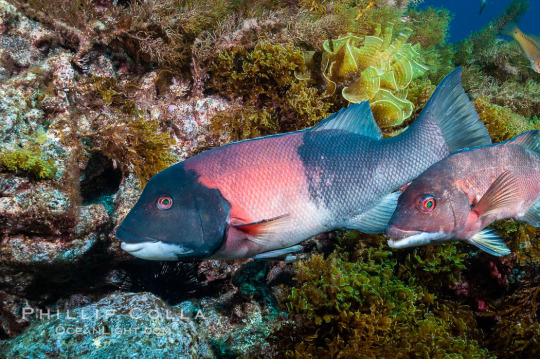
(Image a male and female Sheephead swimming next to each other. The female is roughly half the size of the male. End ID)
During mating season (July-September), males will pick a territory and claim all nearby females as mates. A younger male without a territory may challenge an alpha male to try to claim his territory. These fights are often resolved with threat posturing, but if neither male backs down, they will fight with biting and raking teeth against the opponent. During mating season, females will release batches of 375,000 eggs almost daily for males to fertilize. During this time, the alpha male will patrol his territory to mate as much as possible while chasing off smaller males who may attempt to sneakily fertilize some of his female's eggs. The larvae are planktonic for their first 34-78 days, and will sink as they grow. Juveniles have a different coloration to the adults. They are orange, with a white stripe running down the body and dark spots on the fins. The average maximum age of a California Sheephead is 21 years, but the oldest individual on record was 53 at the time of capture.
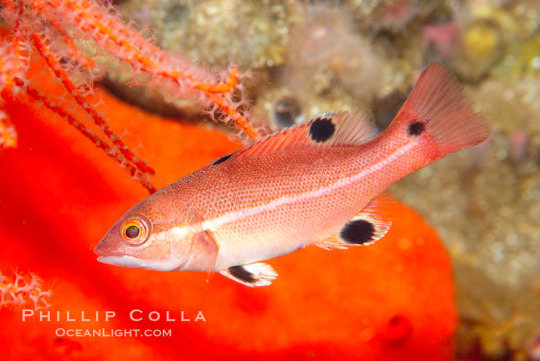
(Image: a juvenile Sheephead. It is a small, orange fish with a white stripe running from eye to tail and black spots on the pelvic, anal, dorsal, and tail fins. End ID)
The California Sheephead lives on rocky reefs and kelp forests from southern California to the Baja peninsula and Gulf of California. They prefer shallow water between 3 and 30 meters (10 - 100 ft) deep, though males will occasionally venture deeper. Sheepheads are predators that hunt hard-bodies invertebrates including urchins, shelled molluscs, and crabs. Juveniles hunt smaller prey such as sponges, bryozoans, and barnacles. The protruding canines give the fish a better grip when trying to pry food off of rocks. They crush the hard shells of the prey with sharp teeth before swallowing. The shells are then further ground down by the throat plates. Smaller individuals have been known to break open urchins too large to bit by picking them up and hammering them into rocks. Sheepheads play an important role in kelp forest ecosystems by keeping urchin populations down. Urchins eat kelp and without predators keeping their numbers in check, can reduce kelp forests to urchin barrens. Sheepheads are known to have a high site fidelity, meaning they will return to the same places over and over. They will maintains a sleeping spot (usually a crevice they can hide in or rock they can hide under) and return to the same places to hunt. They are diurnal and return to their sleeping spots at night to avoid predators.

(Image: a male Sheephead trying to pick up a sea urchin with tis mouth. End ID)
California Sheephead Wrasses are classified as vulnerable to extinction by the IUCN. Their primary threat is overfishing. The Sheepheads have been commercially fished since the 1800s and their numbers have dropped. The hermaphroditic nature of the species actually makes things worse. Commercial fishers are incentivized to catch the largest fish and the largest Sheepheads are the males and females that are likely to transition to male. Unlike with other species, there aren't small males around to make up for the loss of large males to fishing since the small fish are the females. The loss of males and the largest females (who are the ones most likely to transition to male) means there aren't enough males around during mating season to keep the population high enough. The introduction of marine protected areas and fishing regulations have helped the population recover. The loss of the Sheepheads is a big deal since they're one of the species doing the most to keep the kelp forests healthy by eating urchins. Natural predators of the Sheepheads include sharks, sea lions, and giant sea bass.

(Image: a fisherman holding a male Sheephead on a boat. The large canines of the fish are particularly visible. End ID)
#wet beast wednesday#transmasc icons#california sheephead wrasse#sheephead wrasse#wrasse#fish#fishblr#fishposting#pride#hermaphrodite#sequential hermaphroditism#protogyny#marine biology#biology#zoology#ecology#animal facts#educational#informative#image described
100 notes
·
View notes
Text
Fish of the Day
Today's fish of the day is the leopard coral grouper!

The leopard coral grouper, also known as strawberry trout and common coral trout despite not being a trout, scientific name Plectropomus leopardus is a well known marine reef fish! The most widespread fish along the barrier reef, found both from inshore to outer reefs. Found in the Western Pacific ocean stretching from Southern Japan down as far south as Sydney Australia, and a range from as far West as Thailand, and as far East as the Soloman islands. These fish live along coral reefs from depths of 3-100 meters, often living in pairs or small schools along the floor of the reef. These fish can be identified from the other common reef "trout" (these fish are actually groupers) of Australia by the small dark ringed blue circular markings, and the blue ring around the eyes, with an exhibited red, green, pink, or brown coloring depending on population.
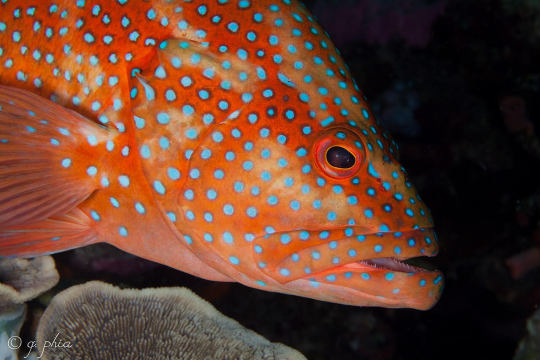
The diet of the coral grouper is made up entirely of other animals. Throughout the majority of their lifecycle, as they are mature adults, they will spend their time on other coral fish, most commonly damselfish species. Although it is very common for larger adults to cannibalize their own species and eat younger coral groupers, including their own children. These fish only feed once every 2-3 days and can hold off starvation for days to weeks at a time if hunting is unsuccessful. Hunting is done by hiding and ambushing prey from below, these fish will camouflage among the corals at the bottom of the reef, waiting for prey to swim over it for a matter of hours at a time.This camouflage is done by quick color changing on the part of the fish, with an ability to change colors in a matter of minutes to plain color or molted patterns. Other times in hunting these fish won't require camouflage at all, instead prowling schools of prey. During this time they will appear as though they are moving slowly toward the prey from an angle, and then quickly change direction of lunge once closer. This diet can allow them to get to sizes as large as 47 inches in length, but most are only 10-15 inches. Too large for most coral and carpet sharks in similar geographic range to predate on them, but some larger sharks still feed on mature adult coral groupers.
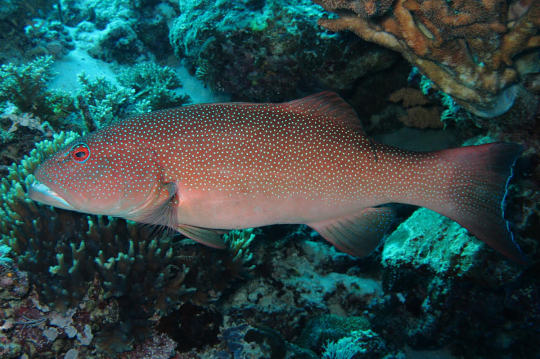
These fish, like many other groupers are protogynous hermaphrodites, these fish begin life as female and will trigger sex change later in life, although currently our understanding of what triggers it is unknown. It is believed to be related to the ratio of male to female fish on the current reef, this change occurs anywhere between the fish reaching a size of 9 inches to 24 inches, and will remain as male for the remainder of their lives. This change does not happen to all female fish that get that large, but it is more common for large coral groupers to transition and for smaller fish to remain female. Once a fish has transitioned to male (a process that can take anywhere from 2 weeks to 2 months) these fish become incredibly territorial,

Between September and December, when it is late spring and summer in the southern areas this fish calls home, the coral grouper is spawning in the North barrier reef, whereas those in more Southern areas, spawn in October to February. The coral groupers in this area will form dense groups at steep slopes of the reef, spawning at a peak of the new moon and at dusk when the light is low and predators are less active to prey on released eggs. These tight groups of fish are formed as a male chooses an area to defend and entice females into his territory with a courtship ritual. This ritual is made up of a male repeatedly darkening and displaying their fins darkened edges, which they change the color of quickly. If a female accepts they will swim in circles toward the surface releasing sperm and eggs before splitting ways. These fertilized eggs will be released into the water stream and larvae will develop in the nearby reefs, becoming fully formed and hunting fry at an age of only 5 weeks. After this, maturity is based on size rather than age itself, and they'll live a long and full 16 years on average unless predated on.

That's the leopard coral grouper, everybody! Hope you have a wonderful day!
#fish#fish of the day#fishblr#fishposting#aquatic biology#marine biology#freshwater#freshwater fish#animal facts#animal#animals#fishes#informative#education#aquatic#aquatic life#nature#river#ocean#Plectropomus leopardus#leopard coral grouper#strawberry trout#common coral trout
38 notes
·
View notes
Text
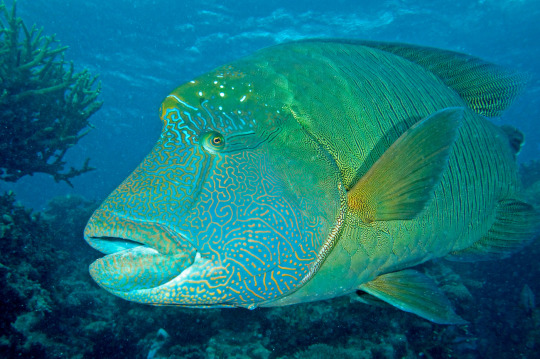
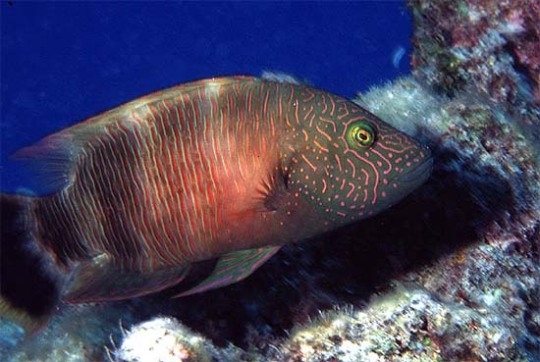
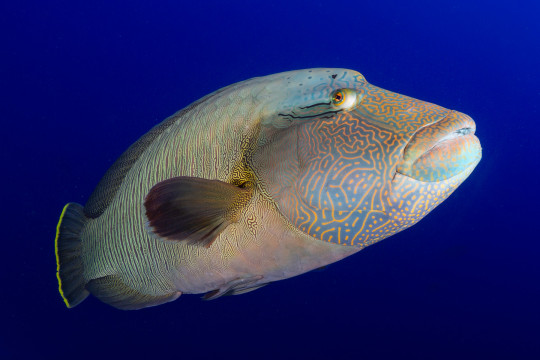
Let's Hear it for the Humphead Wrasse
The humphead wrasse, Cheilinus undulatus, is also known as the Māori wrasse, Napoleon wrasse, or the blue- tooth grouper. They can usually be found around coral reefs and steep rocky cliffs in the Indo-Pacific, particularly on the east coast of Africa, the west coast of India, and the tropical waters of southeast Asia and the Great Barrier Reef.
The Māori wrasse gets its name from the distinctive markings that adults carry. Males are blue-green or purple, while females are more often red or orange. Both have unique patterns of lines and dots covering their heads, and stripes running down the rest of their body; early researchers compared the patterns on their heads to the tattoos traditionally used by the Māori people. In addition to its striking coloration, C. undulatus is also known for being the largest member of the wrasse family. Males can reach up to 2 m (6.5 ft) long and weigh up to 180 kg (396 lbs), while females tend to be smaller. Males also have a large 'hump' on their foreheads, hence the name humphead wrasse.
Another feature of note in C. undulatus is the set of large teeth fused into a parrot-like beak. They use this beak to predate upon hard-shelled animals like mollusks, urchins, sea stars, and crustaceans. On occasion, they also feed on smaller fish and moray eels. Due to their size, adults have very few natural predators aside from sharks, but larvae and small juveniles are more often opportunistically hunted by other fish.
Like many coral reef fish, the humphead wrasse is a protogynous hermaphrodite. This means that most individuals begin life as a female, and become male later in life-- known as 'super males', they are larger than males who did not transition. Individuals first become sexually mature at 5-7 years old, and females begin transitioning to male at 9-12 years old. Spawning occurs a few times a year, and during this period over a hundred adults can congregate in an area. The female releases about 20 eggs into the water column, where they are fertilized by her chosen partner. Three to four weeks later, the eggs hatch and the larvae migrate to the nearby reef.
Conservation status: C. undulatus is considered Endangered by the IUCN. Populations have declined due to overfishing and by-catch mortalities, loss of their food sources, habitat destruction, and capture of juveniles for the aquarium trade.
If you send me proof that you’ve made a donation to UNRWA or another organization benefiting Palestinians– including esim donations– I’ll make art of any animal of your choosing.
Photos
Andrew J. Green
Lluís Masuet
George Ryschkewitsch
#humphead wrasse#Labriformes#Labridae#wrasses#ray-finned fish#bony fish#fish#marine fauna#marine fish#coral reefs#coral reef fish#indian ocean#Pacific Ocean#indo-pacific#animal facts#biology#zoology#ecology
109 notes
·
View notes
Text
Fish Fact Friday! 3-8-24
Eastern Pigfish (scientific name Bodianus unimaculatus) are protogynous hermaphrodites, meaning that they are born female and change sex to male as they mature! At about 2 years old they're a mature female, and at 4 years old they're typically a mature male!

References:
https://fishesofaustralia.net.au/home/species/217
https://www.sydneypremiumcharters.com.au/pigfish-fishing-sydney/
https://en.wikipedia.org/wiki/Sequential_hermaphroditism#:~:text=Protogynous%20hermaphrodites%20are%20animals%20that,especially%20when%20compared%20to%20protandry.
#fish#fish facts#fishfactfriday#fishy#fish fact#eastern pigfish#pigfish#fishblr#send me fish requests :3
40 notes
·
View notes
Text
Alternative language for biology of sex without using "hermaphrodite"
So, you're worldbuilding a scifi alien species or a fantasy race that can reproduce as both male and female. Or you're a biologist or science educator. And you want what you're writing/making to be inclusive to intersex people.
The term hermaphrodite in biology refers to species that can reproduce as both male or female. The problem is it's also a slur when used against intersex people (it's also incorrect - we're not hermaphrodites). I recently polled other intersex folks informally and a plurality were fine with the h-word being used with the correct meaning in appropriate contexts. But the qualitative feedback I got was, all things equal, most people who wrote to me said they'd just be happier seeing the term less.
So here is a glossary of words you can use to talk about the biology of sex without invoking the h-word:
Gonochoric species where individuals (typically) reproduce only as either male or female. This means the species produces two types of gametes that have different sizes, and conventionally the larger is female. Gono- for generation/reproduction and -choric for separated/distinct. Note that "non-gonochoric" includes both hermaphroditic species and those that can reproduce asexually (e.g. parthenogenesis).
Gonosyne: species where individuals (typically) can reproduce as both male or female. Gono- for generation/reproduction and syne for together/combined. This is a term I have coined to be an alternative to hermaphrodite.
Types of gonosyny: it's common to categorize different forms of gonosyny based on temporality and how many gonads an individual has.
Grouping by Temporality:
Cosex: species where individuals can reproduce as both male and female simultaneously. Alternative terms: cosexual, simultaneous hermaphrodism. For example: land snails/slugs typically mate by linking up both pairs of genitals.
Dichosex: gonosynic species where individuals reproduce as male and female at different times in their lives. Protandrous species start as male then switch to female; protogynous start female then switch to male. Some species cycle between the two (serial/bidirectional hermaphrodism/disexuality). Alternative terms: dichosexual, dichogamous, sequential hermaphrodism. I coined this one after feedback that "dichogamous" was not intuitive to non-botanists, keeping dicho- (in two parts/paired) for simplicity. Example animal: clownfish (the Finding Nemo fish).
Grouping by Gonads:
Digonic: species that can reproduce as both male and female because they have separate male and female gonads. Digony can be cosex or dichosex. In botany the term monoecious is used for flowering plants. For example: barnacles have their ovaries in the base of their body, and testes in the back of their head.
Syngonic: species that can reproduce as both male and female, because their gonads can produce both male and female gametes. Alternative terms: syncoecious, monoclinous, ambisexual. (Note ambisexual has other meanings.) Syngony can be cosex or dichosex. In dichosexual species the gonad changes which gametes it produces when the individual changes sex. For example: land slugs have a single gonad (ovotestis).
Together this makes four categories. Examples come from: Sex change in plants and animals: a unified perspective.
Syngonic cosexual. Simultaneous gonosyny within the same flower/gonad. Examples: Black-jack daisy, Lady of the Night cactus; mangrove killifish, stubby-root nematode.
Syngonic dichosexual. Non-simultaneous gonosyny within the same flower/gonad. Examples: Bromelia chrysantha, grape ivy; California sheephead fish, common limpet.
Digonic cosexual. Simultaneous gonosyny from different flowers/gonads. Examples: bitter melon, jaraguá grass; barnacles, flatworms.
Digonic dichosexual. Non-simultaneous gonosyny from different flowers/gonads. Examples: papaya, catsfoot; staghorn coral, earthworm.
Hope this is helpful! I have two little notes I want to add on: Note on "non-gonochoric": it's possible this could also include isogamous speries? There's some ambiguity in use. Isogamy refers to sexual reproduction where you don't have two different sized gametes - instead it's two identically sized gametes that are getting combined. This is the standard amongst unicellular eukaryotes and very common in fungi.
Note on ambisexual: this is the term that Ursula K LeGuin used for the dichosexual aliens in the Left Hand of Darkness. The term in biology these days refers to undifferentiated (immature) tissue that has yet to develop into a given sex - e.g. a human embryo has ambisexual gonads until sexual differentiation later on in development. The term ambisexual has a ton of other meanings in other contexts such as a sexual orientation. For this reason I'd personally avoid it.
#intersex#hermaphrodism#biology of sex#biology#botany#zoology#dichosexual#dichosex#dichosexuality#cosexual#cosex#cosexuality#syngony#digony#gonochoric#gonosynic#worldbuilding#sci-fi#writing#writing scifi#alien design#new term#ambisexual#xenobiology#speculative biology
97 notes
·
View notes
Note
Who did Cad Bane lose his virginity to and what were the circumstances around it?
Warning: NSFW content and discussion about Duros anatomy and loss of "virginity."
There are two answers here that I can give you. One spoils a bit of the fic I plan to start writing this year, damn it, and is full of angst and not voluntary on Bane’s part, though he is not known as “Bane” then, and is fairly young, considering.
The other answer is Jango Fett.
As I have explained before, I have two versions of Bane that live in my head.
The version I write with readers who is sexually deviant, and the version that I consider to be my “Cad Bane canon” in relation to other canon characters, where he is more so guarded and wary toward anyone, and very particular. Exhibits “brat behavior,” or generally pretends to care less about intimacy.
Voluntarily, he gives himself to Jango. This would be after much time is spent together; the time left unexplored where Fett was labeled Bane’s “mentor” (this is briefly mentioned in a magazine, and I ran with it, because I absolutely fucking LOVE the idea).
The circumstances have yet to be completely hashed out, but I see Cad thinking he has embarrassed himself, approaching Fett in a way that he realizes could have been due to false signals, or reading Jango wrong. Jango may be surprised at first, but indulges him. Mostly because he wants to, and maybe he does feel some kind of way about him.
I see them at first as rivals. Bane is stubborn, but good at what he does. He sees his potential. Maybe for a time he feels that need to “father or mentor” someone in relation to Bane, as Boba eventually is the outcome of this desire in Fett. As time wears on, there is an attraction there. I see them being physical, especially during sessions where they train together. Maybe one of these gets heated, and a little personal. Maybe Bane slips up and touches Jango in a particular way, acting as a catalyst to the scene that unfolds afterward.
I have ideas, friend. So many ideas. >D
In relation to the real loss of his “virginity,” let’s just say that it’s a “power move” made on a young Duros who is just trying to find his way in an all too harsh galaxy, one that surpasses sexual dimorphism and leans into an area of “sequential hermaphroditism” (a scientific term) in regard to the “animal” kingdom, or in relation to a headcanon I have where Duros are a species that begin as protogynous, or female.
Some Duros never move beyond that, but some “choose” to be males, whereas Bane here could not decide, and ultimately develops and maintains both sexual characteristics. He experiences harassment and ridicule, among other things, for being “different,” but there are also those who would take advantage of him, and this is one such case.
#Cad Bane#Jango Fett#Star Wars#Fanfic#My Writing#Headcanons#Anonymous Ask#Alien Anatomy#Duros Headcanons#Duros
21 notes
·
View notes
Text
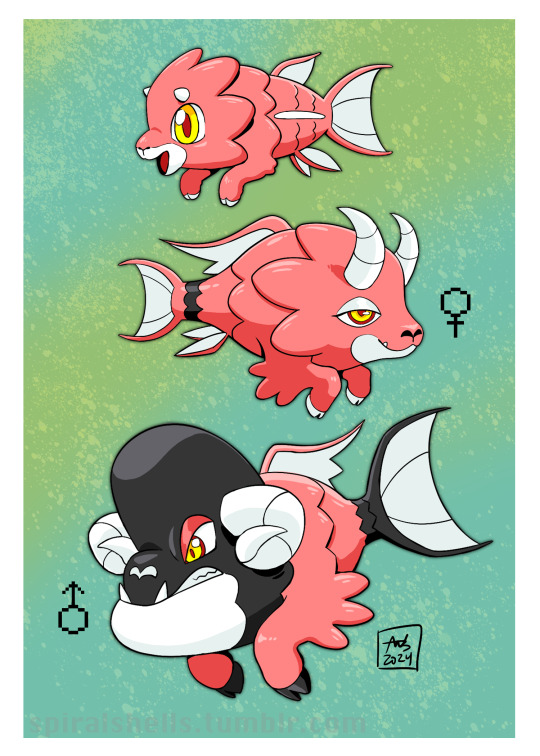
Was going through old sketchbooks recently and came across a set of drawings from when I was working on some Fakemon species for a California-based setting. This is one of my favorites, a line based on the California sheephead wrasse (with a little native bighorn sheep thrown in). Like its inspiration, it is a protogynous hermaphroditic species: all are born female, but the most dominant adult females in their territories transition to male.
From top to bottom, their names are Lambish, Yuwish, and Rambish. All Lambish are female and evolve into Yuwish by level-up. A Yuwish becomes a Rambish by winning a number of consecutive battles against other Yuwish (for the actual fish I think the transition usually occurs in the largest-sized females, but for a Pokemon setting I thought this sounded more fun than just grinding for an extra-large one).
16 notes
·
View notes
Text
Transphobes had a meltdown after the British Library celebrated Pride Month by tweeting about a fish that can change its sex, and the backlash became so intense that the library deleted the entire thread.
“This #Pride month, let us tell you about the Māori wrasse (also known as the humphead wrasse) But its wondrous forehead isn’t the most magnificent thing about this fish – they are protogynous hermaphrodites, which means the females can later change sex to become males.”
23 notes
·
View notes
Text

there's a fish (bluethroat wrasse, Notolabrus tetricus) that looks like the trans flag and it's a protogynous hermaphrodite!!! (young ones are female but change to male later in life)
3 notes
·
View notes
Text
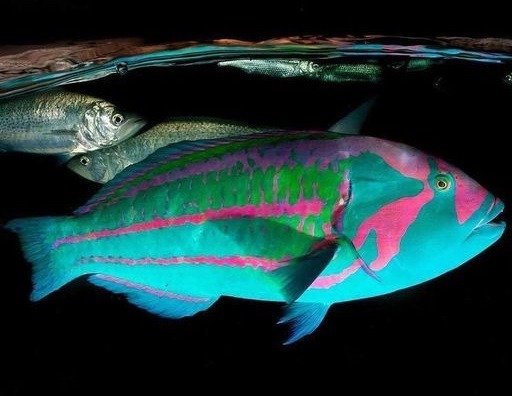
Surge Wrasse (Thalassoma purpureum), family Labridae, order Labriformes, Lord Howe Island, Australia
These fish are protogynous hermaphrodites. They all hatch out as females, and turn into males later in life.
photograph by Jordan Robins
336 notes
·
View notes
Text
Daily fish fact #474
Potter's angelfish!

They can be kept in reef aquariums, but as their diet consists largely of algae and detritus, it is recommended that your tank be already well established before obtaining any! They're protogynous hermaphrodites, all fish being born female and then some becoming male later in life, often the males having a harem of several females.
#fish#fishfact#fish facts#fishblr#marine life#marine animals#marine biology#sea creatures#sea animals#sea life#biology#zoology#potters angelfish#potters angel#potter's angelfish#marine angelfish
280 notes
·
View notes
Text
Someone explain to me why science accounts on Twitter are like “hey lgbts! This fish species is a protogynous hermaphrodite! Happy pride!” Like. The fact of the matter is that this fish species being like that has no bearing on Homo sapiens, for whom hermaphroditism is an anomaly on an individual basis.
2 notes
·
View notes
Text
Fish of the Day
Today's fish of the day is the Humphead Wrasse! Thank you Three for the suggestion!
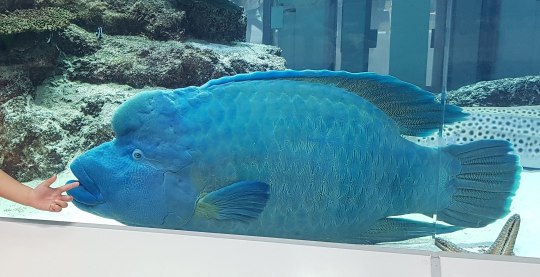
The humphead wrasse, also known as the Māori wrasse, Napoleon wrasse, and Napoleon fish, scientific name Cheilinus undulatus is an endangered fish found around coral reefs. Primarily found in the indo-Pacific ocean, their range stretches from the Eastern side of Africa to as far East as the islands of Oceania. Other populations live in lagoons, estuteries, and the red sea, thriving on the reefs within. Juveniles prefer to live on sandy banks, closer to the surface, but fully mature wrasse prefer to live a bit deeper in the waters. Anywhere from 3-350ft into the depth of the water, where offshore corals thrive.
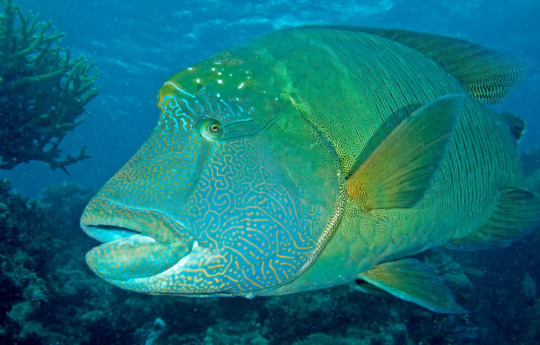
The diet of the humphead wrasse consists of mollusks, crustaceans, urchins, and smaller fish. But, the most impressive thing about their diet is the ability to eat toxic animals. More importantly, their ability to eat crown-of-thorns starfish, which are a common reason for disease in coral reef systems, as these starfish eat coral at a faster rate then they can grow in natural condition and the recent surge in population is one of the larger reasons for coral loss. The wrasse's ability to eat these is essential to their home ecosystem. Their diet can also support their large size, with females only getting as large as a meter, but males coming in as large as 2 meters (a little larger than 6 feet). Predated by sharks, but one of their main issues, and cause for endangerment is due to overfishing by humans, along with illegal aquarium trading. This combined with habitat loss is what makes it so important we watch their numbers closely.
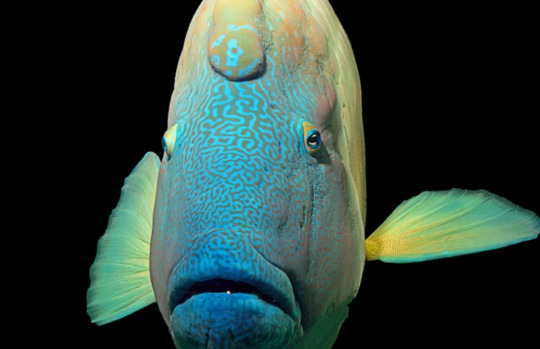
Reproduction of the humphead wrasse is much like that of others in the wrasse family. Wrasse are protogynous hermaphrodites, meaning that they can switch sexes throughout their lives, although the timing behind sex change is still unknown. All humphead wrasse are born female, and most switch to male at about 9 years old. Spawning will take place at reef edges, and eggs will rest on or near coral until hatching. The first 5-7 year of their lives juvenile, but after they will choose sex based on the population needs of their reef, and live another 30-40 years before dying.
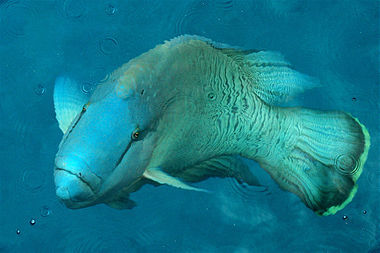
Have a wonderful day, everyone!
#fish#fish of the day#fishblr#fishposting#aquatic biology#marine biology#animal facts#animal#animals#fishes#informative#education#aquatic#aquatic life#nature#ocean#humphead wrasse#wrasse#Cheilinus undulatus#reef#coral reef#indo-pacific
21 notes
·
View notes
Text
Animal Crossing Fish - Explained #233
Brought to you by a marine biologist who uses tools to get shit done...
CLICK HERE FOR THE AC FISH EXPLAINED MASTERPOST!
If you're familiar with the debate surrounding animal intelligence, you've probably heard about the many tests animals can be given to test their level of intelligence. These tests are how we have determined that dolphins and great apes are smart as hell while most other animals really aren't. Now, we don't have a lot of time to talk about intelligence, but please understand that intelligence, like any trait, is useful for some but not for others, and that doesn't make those others lesser. Anyway, one test for intelligence is the use of tools, and today's fish - the Blackspot Tuskfish - was the first fish discovered to do just that.
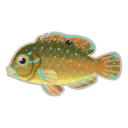
The Blackspot Tuskfish (acronym from now on - BSTF) appeared for a short while in Animal Crossing Pocket Camp for their Fishing Tourney #53, the Oasis Patio. This event occurred during August 2022, and the BSTF hasn't been seen since.
The BSTF is a species of wrasse belonging to Order Labriformes which includes the wrasses, parrotfish, and cales. These fish are most often associated with coral reef habitats and feed on a variety of organisms and algae, depending on species. Within Labriformes is Family Labridae which are the wrasses specifically. They are known to be incredibly colorful, and most are protogynous hermaphrodites, meaning they begin life as females and become male as they grow larger. Some, like the tuskfish (Genus Choerodon), have large, sharp teeth - "tusks" - and powerful jaws they use to crunch on bivalves and other hard prey. The BSTF (Choerodon schoenleinii) is a native to Indo-Pacific near-shore coral reefs, from East Africa out to various Pacific islands, where it does just that.

From https://fishesofaustralia.net.au/home/species/1928
When the BSTF finds a bivalve is just can't crack with its jaws alone, it goes looking for something to help it, like a rock it can smash the bivalve into. In July 2011, this behavior was finally documented, providing evidence to support the notion that wild fish can use tools. At least for BSTF, it was given that seal of approval, as using the rock to help it feed fit the accepted definition of tool use.
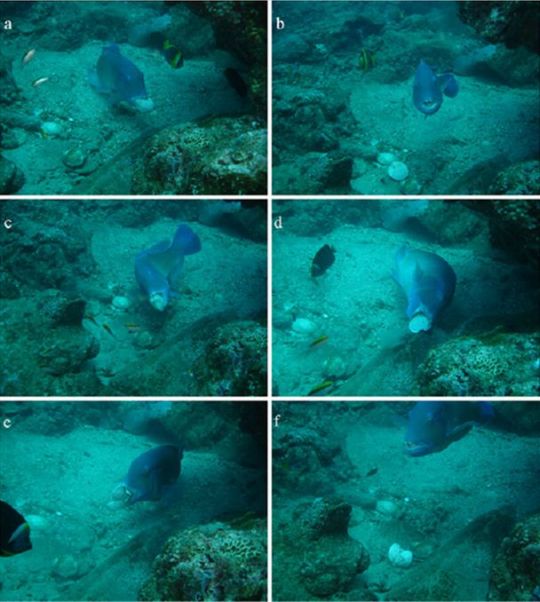
From https://phys.org/news/2011-07-photo-fish-tools.html
Fish are smarter than people give them credit for. At the end of the day, it's really hard to determine how smart a creature like a fish, that has evolved over millennia in an environment so unlike ours, is. We can't simply compare their intelligence to ours, nor should we snub our noses at animals that just don't have it. You wouldn't like it if a fish judged you based on how well you could breathe underwater.
And there you have it! Fascinating stuff, no?
#blackspot tuskfish#fish#animal crossing#animal crossing pocket camp#acpc#animals#marine biology#ocean#science#science in video games#animal crossing fish explained
4 notes
·
View notes